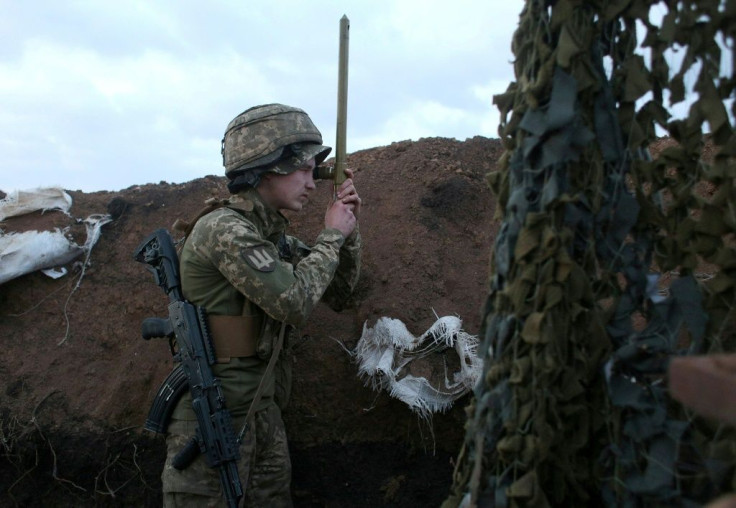Will Russia Invade Ukraine? Putin Steadily Raised Firepower At Border
KEY POINTS
- Russia has deployed 40,000 soldiers in Crimea and another 40,000 in other borders
- It has deployed tanks, infantry fighting vehicles and Iskander short-range missiles
- Current standoff may be aimed at testing Biden's Russia-Ukraine policy
The world is caught up in a guessing game. Reports on Russia's troop build-up near Ukraine, which the United States calls the "the largest concentration of Russian forces on Ukraine's borders since 2014" have sparked fears of war in Kyiv and NATO capitals alike.
While Russian President Vladimir Putin's spokesman maintained "nobody is planning to move towards war," the massive deployment has raised concerns, especially in light of Dmitry Peskov's veiled threat that Moscow "will not remain indifferent to the fate of the Russian-speaking populace in the region."
Peskov was referring to the half a million people in the self-proclaimed 'Donetsk and Luhansk people's republics' who have been issued with Russian passports since 2014.
But, what exactly is happening on the Russia-Ukraine border? Russia has deployed 40,000 soldiers in Crimea and another 40,000 in other regions along the border, including tanks, artillery and other units, BBC reported.
Janes, a source for defense intelligence, has identified at least 14 Russian Ground Troop units that have moved or are moving to the Ukrainian area of operations since late March. It also identified the Central Military District troops from the 74th and 35th Motorised Brigades, 120th Artillery Brigade, and the 6th Tank Regiment, equipped with tanks, infantry fighting vehicles, and long-range artillery, including self-propelled guns and multiple rocket launchers.
Besides, Russia is also said to have deployed Iskander short-range ballistic missile systems along the border.
The first spot of the Iskander column comes from unsurprisingly from Tiktok on 25 MAR 2021 on the highway between Ekaterinburg and Chelyabinsk. Note the white camo and the number 121 on the first green transloader. pic.twitter.com/1o2A72ECEB
— tom (@tom_bullock_) April 8, 2021
Given that the Russian military has an estimated 800,000 to 900,000 troops, "that would be approximately 10 percent of the Russian military's total manpower," Rob Lee, a former U.S. Marine who now tracks military deployments at the Department of War Studies at King's College London, told NBC News.
While that may be the situation, analysts say it is unlikely that Russia would go to war with Ukraine now. Because the slow and overt build-up isn't exactly Russia's style. Infiltration would be more Russia's tried-and-trusted method as it did in Crimea in 2014, BBC reported.
During 2014's Crimea annexation, Russia sent thousands of extra soldiers quietly into the bases that it was permitted by the treaty to own in Crimea. Desicribed as the smoothest invasion of modern times, it was mostly bloodless.
Analysts also think the current build-up is an attempt to intimidate Ukraine, as a genuine invasion would be "rapid and more covert" while serving as a test to U.S. President Joe Biden too, who has taken a tougher stance on Russia. Relations between the two leaders have been frosty since Biden agreed with a description of Putin as a "killer." Putin had hit back at the insult, saying "it takes one to know one". Last month the U.S. announced $125 million in military aid to Ukraine, a move that didn't sit well with Kremlin.
Though U.S. Secretary of State Antony Blinken warned Russia of "consequences" if it "acts recklessly, or aggressively" against Ukraine, Biden later telephoned Vladimir Putin, inviting him to hold a summit between the two nations, termed as a win for Putin.
Soon, news also broke that the US also canceled this week's planned deployment of two warships to the Black Sea. Russia had warned against the deployment of U.S. warships, asking them to stay well away from Crimea "for their own good."
Speculations are also rife that the latest Ukraine standoff is Putin's way of dealing with parliamentary elections in September and a continuing mass movement supporting his jailed arch-critic Alexei Navalny. Kremlin "defending" marginalized Russians in Ukraine may help him tide over the Navalny wave.

© Copyright IBTimes 2024. All rights reserved.





















